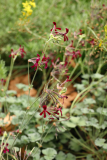Additional notes (click to expand)
Medicinal
Traditional Herbal Medicine Registration (THMR).
Traditionally used to treat gonorrhoea, diarrhoea, dysentery. Currently , for acute bronchitis in children and adults: ethanolic extracts of root are used in proprietary herbal tincture known as 'Umkaloabo'. Efficacy has been clinically proven(special extract)(Brendler and Van Wyck,2008)Overall safety and a very low incidence of side effects have been confirmed (Conrad et al,2007).
Brendler, T., Eloff J.N., Gurib-Fakim, A.,Philips, L.D. (2010) African Herbal Pharmacopoeia. Association for African Medicinal Plant Standards.
Umckaloabo- coumarins from the root, traditionally used to treat bronchitis in children, have anti-bacterial and anti-viral properties.
A South African native medicine traditionally made from the tubers of Pelargonium sidoides +/- P. reniforme , said to have anti-diarrhoeal affects but principally used for acute bronchitis, coughs and colds. It is widely marketed in Europe for the respiratory indications. A Cochrane review found some evidence of efficacy but the quality of evidence was low to very low (Timmer A et al, Cochrane Database of Systematic Reviews 2013; 10: CD006323)
A Major Stevens who had been in S.Africa set up a company in 1907 in Wimbledon producing ‘Stevens’ cure for tuberculosis’ – Umckaloabo. He wrote several books promoting this and was the subject of numerous court cases. His cause was taken up by a Swiss physician, Dr Adrien Sechehaye, who continued to publish positive clinical papers on the medicine until the 1930s. The ‘cure’ was debunked by the BMA in one of their reports on quack medicines – ‘Secret Remedies – and what they contain’.
Not Known (NS)
Stevens’ Cure (Umckaloabo)—the vindication of a patent medicine. T. Brendler1, M. A. Stander, and B.-E. van Wyk
Stevens’ Cure (Umckaloabo) emerged as a patent medicine claiming to treat
tuberculosis in the United Kingdom at the beginning of the 20th century.
However, due to its identity being shrouded in secrecy, it was never truly
accepted by the medical community. It was “rediscovered” in the 1970s and
subsequently developed into a very popular and successful phytopharmaceutical
for the treatment of upper respiratory tract infections.
For full article see Location below.
https://www.frontiersin.org/articles https://www.frontiersin.org/articles/10.3389/fphar.2023.1294997/full#:~:text=Stevens'%20Cure%20(Umckaloabo)%E2%80%94the%20vindication%20of%20a%20patent%20medicine,-T.&text=Stevens'%20Cure%20(Umckaloabo)%20emerged,accepted%20by%20the%20medical%20community
Toxicity
Overall safety and a very low incidence of side effects have been confirmed (Conrad et al, 2007).
Brendler, T., Eloff J.N., Gurib-Fakim, A.,Philips, L.D. (2010) African Herbal Pharmacopoeia. Association for African Medicinal Plant Standards.
Side effects/precautions: Do not use if hypersensitivity, increased tendency to bleeding, using coagulation-inhibiting drugs, severe hepatic and renal diseases, pregnant, breast feeding; may cause gastrointestinal disorders, skin and subcuteanous disorders, vascular disorders, respiratory, thoracic and mediastnal disorders, cardiac orders, hepatobiliary disorders. From Patient information leaflet for preparations licensed as Traditional Herbal remedies in the UK
Medicines and Health Care Regulatory Authority, 2013 Licensed Traditional Herbal Remedies
Geographical distribution
- Africa, Southern Africa, Cape Provinces
- Africa, Southern Africa, Free State
- Africa, Southern Africa, Lesotho
Pelargonium sidoides DC.
Family: GERANIACEAEGenus: Pelargonium
Species: sidoides DC.
Common names: Kalwerbossie; Rabassam; Umckaloabo
Distribution summary: Southern Africa
Habit: Perennial
Hardiness: H3 - Half hardy; unheated greenhouse/mild winter
Habitat: Short grassland on stony soil, from sea level to 2300m
Garden status: Currently grown
Garden location: Southern Hemisphere Wolfson bed (N), Plants in pots (POT)
Flowering months: June, July, August, September, October, November
Reason for growing: Medicinal, traditional herbal registration

.JPG)
.JPG)
.JPG)
.JPG)
.JPG)

.JPG)